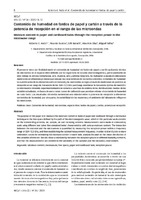Contenido de humedad en fardos de papel y cartón a través de la potencia de recepción en el rango de las microondas
Moisture content in paper and cardboard bales through the reception power in the microwave range
Date
2020-11-27Author
Aedo, Roberto E.
Bustos, Ricardo
Baradit, Erik
Diaz, Mauricio
Yañez, Miguel
Metadata
Show full item recordAbstract
El presente tiene por finalidad medir el contenido de humedad en fardos de papel y cartón aplicando técnica de microonda en el espacio libre definido por la trayectoria de la onda electromagnética, particularmente en este trabajo es antena transmisora, aire, muestra, aire y antena receptora. Se realizaron a escala de laboratorio mediciones en diferentes probetas que simulan las características de los fardos a distintos contenidos de humedad. La cuantificación de la interacción entre el material y las microondas se logra a través de mediciones de potencia en recepción en un rango de frecuencia de los 3,84-12,5 GHz para luego establecer la frecuencia óptima de medición. La información obtenida experimentalmente se somete a una fase de análisis de las distribuciones medias de las variables estudiadas, en busca de una o varias curvas de calibración que permitan estimar el contenido de humedad en cada fardo. Los resultados obtenidos evidencian una relación entre la potencia de recepción a diferentes contenidos de humedad, por otra parte, la variabilidad de las muestras y el ambiente del laboratorio influye en las mediciones. The purpose of this paper is to measure the moisture content in bales of paper and cardboard through a microwave technique in the free space defined by the path of the electromagnetic wave, which in this particular work consists on the transmitting antenna, air, sample, air and receiving antenna. Measurements were made at a laboratory scale using different test tubes that simulated bales’ characteristics with various moisture content. The interaction between the material and the microwaves is quantified by measuring the reception power within a frequency range of 3,84-12,5 GHz, and then establishing the optimal measurement frequency. In order to identify one or more calibration curves for estimating the moisture content in each bale, analysis focused on the mean distribution of the variables of interest. Results show a relationship between the reception power at different humidity contents, and that the measurements are sensible to the variability of the samples and the laboratory environment.
URI
https://hdl.handle.net/20.500.12219/2832https://doi.org/10.36995/j.recyt.2020.34.001
https://www.fceqyn.unam.edu.ar/recyt/index.php/recyt/article/view/579
Collections
The following license files are associated with this item:




